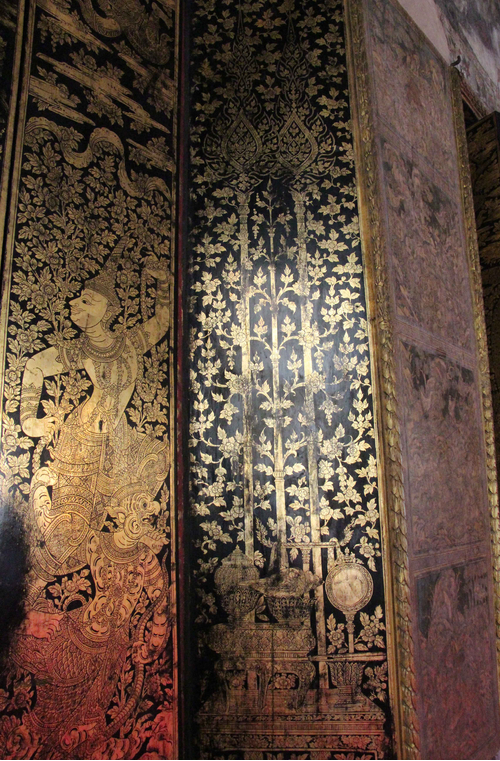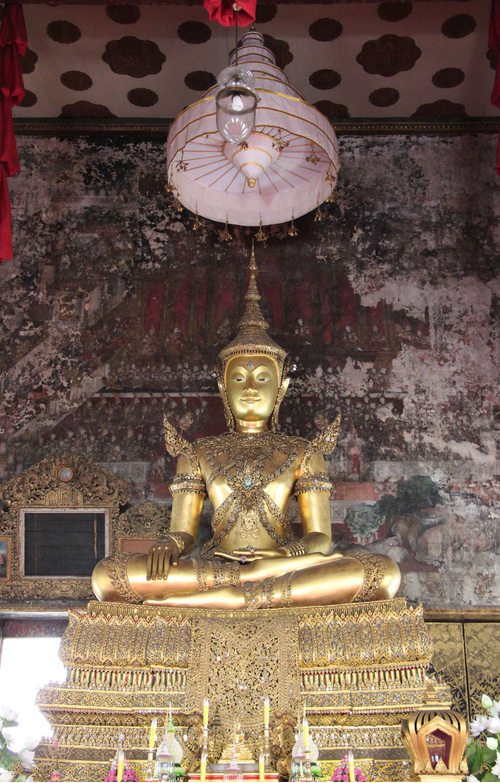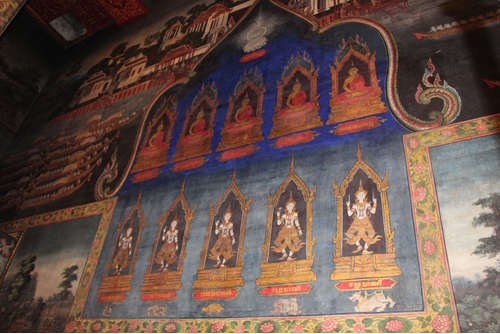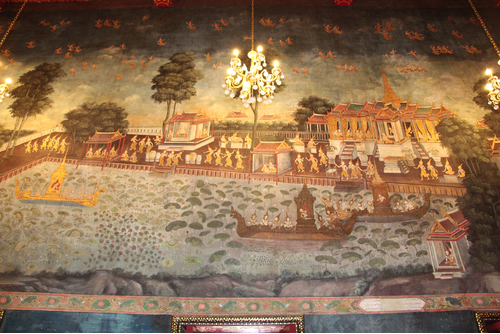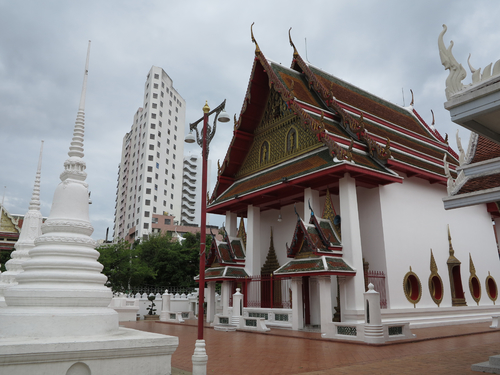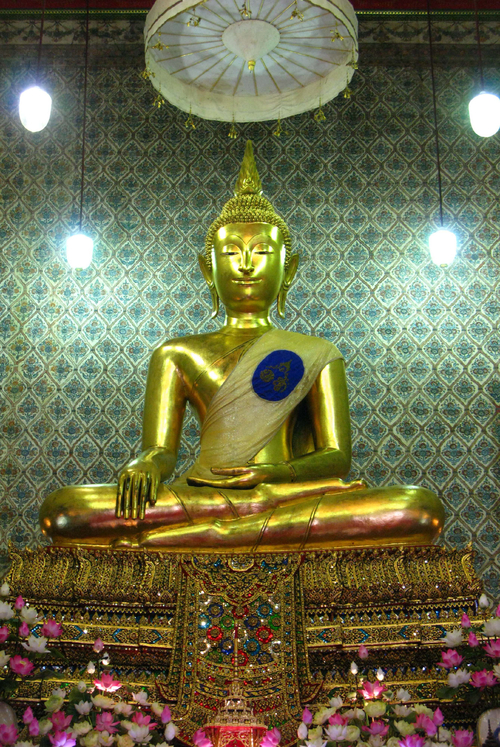ค้นหางานศิลปกรรม
ฐานข้อมูลศิลปกรรมในเอเชียตะวันออกเฉียงใต้
จิตรกรรมลายรดน้ำเครื่องราชูปโภค
จิตรกรรมลายรดน้ำที่บานแผละประตูและหน้าต่างภายในพระอุโบสถวัดนางนองมีทั้งหมด 28 ภาพ เขียนภาพเครื่องราชูปโภค เครื่องราชกกุธภัณฑ์ เครื่องยศ เครื่องสิริมงคล เครื่องศัตราวุธ เครื่องดนตรีที่ใช้ประกอบพระราชพิธีต่างๆ โดยมีภาพเครื่องสูง ได้แก่ ฉัตร บังสูรย์ บังแทรก ประกอบอยู่เบื้องหลัง ลวดลายทั้งหมดปิดทองคำเปลวบนพื้นรักสีดำ
จิตรกรรมจิตรกรรมลายกำมะลอ
ภาพจิตรกรรมลวดลายอย่างจีน เขียนด้วยสีฝุ่นผสมทองคำเปลว บนพื้นรักสีดำเป็นรูปเทพเจ้าฮก ลก ซิ่ว ตามคติความเชื่อในลัทธิหรือศาสนาเต๋า แต่งกายอย่างจีน พร้อมด้วยบริวาร
ประติมากรรมพระพุทธมหาจักรพรรดิ
พระพุทธรูปประทับนั่งขัดสมาธิราบ แสดงปางมารวิชัย พระวรกายเพรียว พระพักตร์ค่อนข้างกลมกึ่งรูปไข่ พระขนงโก่ง พระเนตรเรียวเล็ก พระโอษฐ์อ่อนโค้งเล็กน้อยจนเกือบเป็นเส้นตรง พระพักตร์คล้ายหุ่น อันเป็นรูปแบบเฉพาะของพระพุทธรูปในรัชกาลที่ 3 ทรงเครื่องประดับต่างๆ ได้แก่ พระมหามงกุฎ กรองศอ สังวาล พาหุรัด ทองพระกร ทองพระบาท
สถาปัตยกรรมจิตรกรรมเรื่องพระพุทธเจ้าและพระโพธิสัตว์มหายาน
องค์ประกอบของภาพจิตรกรรมเรื่องนี้เขียนบนฉากหลังสีน้ำเงินเข้มมีกรอบคดโค้งยอดแหลม ภายในพื้นที่นั้นประกอบด้วย ภาพพระพุทธรูป 5 พระองค์ ประทับนั่งเรียงเป็นแถว พระพุทธรูปแต่ละองค์ครองจีวรสีเข้มเกือบเป็นสีแดง ห่มจีวรเฉียง ผ้าจีวรเรียบไม่มีริ้ว มีสังฆาฏิเป็นแถบขนาดเล็กพาดจากพระอังสาซ้ายยาวจรดพระนาภี พระพักตร์และพระวรกายปิดทอง เหนือพระเศียรมีพระรัศมีเปลวปิดทองโดยไม่มีอุษณีษะ ซึ่งเป็นลักษณะสำคัญของพระพุทธรูปแบบพระราชนิยมในรัชกาลที่ 4 พระพุทธรูปทุกองค์แสดงปางสมาธิ ประทับนั่งบนฐานกลีบบัวซึ่งรองรับด้วยฐานสิงห์ภายในเรือนแก้วที่มีลักษณะเป็นซุ้มคดโค้ง ปลายซุ้มทั้ง 2 ข้างมีลักษณะคล้ายหางหงส์หรือเศียรนาคที่หันหน้าไปด้านข้าง ยอดกลางเป็นกระหนกคล้ายกับเศียรนาคหันหน้าตรง ด้านบนซุ้มประดับพุ่มไม้โพธิ์มีลายกระหนกเปลวล้อม ซึ่งลักษณะดังกล่าวเป็นรูปแบบของซุ้มพระพุทธรูปแบบพระราชนิยมในรัชกาลที่ 4 เช่นกัน ใต้ฐานพระพุทธรูปแต่ละองค์มีกรอบข้อความอักษรขอมสีทองบนพื้นสีแดงเหนือแถวภาพพระพุทธรูปทั้ง 5 พระองค์ มีรูปอุณาโลมเปล่งรัศมีเหนือดอกบัว กลางอุณาโลมมีอักษรขอม ใต้ดอกบัวมีอักษรขอมบนพื้นสีแดง ด้านล่างของแถวพระพุทธรูปเป็นภาพบุคคลแต่งกายคล้ายเทวดา 5 องค์ ทุกองค์ทรงเครื่องประดับซึ่งมีการปิดทอง ประกอบด้วยมงกุฎมีกรรเจียกจร กรองศอ สังวาล พาหุรัด ทองกร นุ่งผ้าเขียนลายประดับชายไหวชายแครง สวมทองพระบาทและฉลองพระบาท ประทับยืนบนแท่นประดับผ้าทิพย์ ภายในซุ้มเรือนแก้วที่คล้ายกับซุ้มเรือนแก้วของพระพุทธรูปทั้ง 5 องค์ แต่ไม่มีไม้โพธิ์ประดับ ใต้ฐานที่ประทับของแต่ละองค์มีกรอบข้อความอักษรขอมสีทองบนพื้นสีแดง พร้อมทั้งมีภาพสัตว์ ได้แก่ ไก่ นาค เต่า โค และสิงห์ภาพทั้งหมดนี้มีความเกี่ยวข้องกับคติความเชื่อในพุทธศาสนามหายาน เนื่องจากอักษรขอมที่ปรากฏใต้ภาพพระพุทธรูปแต่ละองค์นั้นอ่านได้ว่า “ไวโรจนะ” “อักโษภยะ” “รัตนสัมภาวะ” “อมิตาภะ” และ “อโมฆสิทธิ” โดยเรียงตามลำดับจากซ้ายไปขวา ซึ่งชื่อดังกล่าวสอดคล้องกับข้อความอักษรขอมที่อยู่ใต้รูปอุณาโลม และอยู่เหนือภาพพระพุทธเจ้าเหล่านั้นซึ่งอ่านได้ว่า “ธยานิพุทธา”ส่วนอักษรขอมที่อยู่ใต้ภาพบุคคลที่แต่งกายคล้ายเทวดาทั้ง 5 องค์นั้น อ่านได้ว่า “สมันตภัทร” “วชิรปาณี” “รัตนปาณี” “ปัทมปาณี” และ “วิศวปาณี” ดังนั้นจึงสอดคล้องกับภาพพระธยานิพุทธเจ้าแต่ละองค์ที่มีพระโพธิสัตว์ประจำองค์อยู่เบื้องล่าง และเชื่อว่าภาพสัตว์ที่อยู่เบื้องล่างของพระโพธิสัตว์แต่ละองค์นั้น เป็นสัญลักษณ์สื่อแทนพระพุทธเจ้าทั้ง 5 องค์ที่ตรัสรู้ในโลกมนุษย์ ภาพอุณาโลมที่อยู่ด้านบนสุดนั้น ภายในมีอักษรขอม 3 ตัวซึ่งอ่านได้ว่า อะ อุ มะ หรือ โอม อันเป็นคำกล่าวสรรเสริญบูชาเทพเจ้าตามคติความเชื่อในศาสนาพราหมณ์มาแต่โบราณ แต่น่าสนใจว่าได้นำมาเขียนไว้เหนือข้อความและภาพของพระธยานิพุทธเจ้าซึ่งเป็นเรื่องในพุทธศาสนา
สถาปัตยกรรมโพธิฆระ
รูปแบบของบริเวณที่ประดิษฐานต้นโพธิ์บางแห่งพบว่ามีการทำฐานโพธิ์ล้อมรอบโคนต้น มีลักษณะเป็นฐานสิงห์ในผังสี่เหลี่ยมจัตุรัส มีพนักกำแพงโดยรอบทำด้วยกระเบื้องปรุแบบจีน และมีบันไดทางขึ้นโดยอาจมีเพียงด้านเดียวหรือทั้ง 4 ด้าน มีบางแห่งที่มีอาคารล้อมรอบต้นโพธิ์ที่เรียกว่าโพธิฆระ เช่นที่วัดปทุมวนาราม และวัดบวรนิเวศวิหาร โพธิฆระมีแผนผังเป็นสี่เหลี่ยมจัตุรัส มีหลังคาคลุมและมีพนักกำแพงบนสันหลังคาโดยเว้นพื้นที่ตรงกลางเพื่อให้ต้นโพธิ์ได้เจริญเติบโต
จิตรกรรมจิตรกรรมเรื่องสวรรค์ชั้นดาวดึงส์
ผนังภายในรอบพระอุโบสถเหนือช่องหน้าต่าง เขียนภาพสวนสวรรค์ทั้ง 4 แห่ง บนสวรรค์ชั้นดาวดึงส์ สวนแต่ละแห่งมีองค์ประกอบคล้ายกัน โดยภาพเทวดานางฟ้าที่แต่งองค์ทรงเครื่องอย่างตัวละครเอกในงานจิตรกรรมประเพณี มีภาพสถาปัตยกรรมทรงปราสาทที่คล้ายกับพระมหาปราสาทในพระบรมมหาราชวัง เบื้องหลังเต็มไปด้วยแมกไม้และท้องฟ้าที่มีภาพเทวดาและนางฟ้าเหาะอยู่ท่ามกลางก้อนเมฆ ด้านหน้าของฉากพระมหาปราสาทเป็นภาพสระบัวขนาดใหญ่ที่มีเรืออยู่กลางสระ มีลักษณะคล้ายเรือพระที่นั่ง ฉากด้านหลังพระประธานเขียนเรื่องช้างเอราวัณที่เชื่อกันว่าแต่ละงามีสระบัว 7 สระ แต่ละสระมีดอกบัว 7 ดอก แต่ละดอกมีกลีบ 7 กลีบ และมีเทพธิดาสถิต 7 องค์
สถาปัตยกรรมพระอุโบสถวัดทองนพคุณ
พระอุโบสถเป็นอาคารทรงไทยประเพณี ตัวอาคารก่ออิฐถือปูน หลังคาซ้อนชั้นเครื่องไม้มุงกระเบื้อง หน้าบันประดับช่อฟ้า ใบระกา หางหงส์ นาคสะดุ้ง สันนิษฐานว่าเป็นงานในรุ่นหลังรัชกาลที่ 3 เนื่องจากมีการประดับตกแต่งที่ใช้รูปสัญลักษณ์ต่างๆ มากยิ่งขึ้นซึ่งเป็นลักษณะเฉพาะในสมัยรัชกาลที่ 4 หน้าบันพระอุโบสถซ้อน 2 ชั้น ชั้นบนเป็นรูปพานประดิษฐานพระไตรปิฎก ขนาบด้วยเชิงเทียน ชั้นล่างเป็นช่องประดับปริมากรรมรูปเทพนม โดยน่าจะมีความสอดคล้องกับภาพจิตรกรรมภายในพระอุโบสถที่เขียนภาพคัมภีร์พระไตรปิฎก ช่องประตูทางเข้าพระอุโบสถมี 3 ช่อง ซุ้มประตูช่องกลางเป็นรูปมงกุฎ อีก 2 ช่อง เป็นซุ้มยอดทรงปราสาท ซุ้มหน้าต่างช่องกลางเป็นรูปมงกุฎ อีก2ซุ้มที่ขนาบข้างเป็นรูปพัดยศ
ประติมากรรมพระพุทธมหาโลกาภินันทปฏิมากร
พระพุทธมหาโลกาภินันทปฏิมากรมีรูปแบบเฉพาะของพระพุทธรูปที่สร้างในสมัยรัชกาลที่ 3 อย่างแท้จริง กล่าวคือ พระวรกายเพรียวบาง พระพักตร์ค่อนข้างกลมกึ่งรูปไข่ ขมวดพระเกศาเล็ก พระรัศมีเป็นเปลว พระขนงโก่ง พระเนตรเรียวเล็ก พระโอษฐ์อ่อนโค้งเล็กน้อยจนเกือบเป็นเส้นตรง พระพักตร์คล้ายหุ่น ขมวดพระเกศาเป็นเม็ดเล็ก มีอุษณีษะรองรับพระรัศมีเปลว ประทับนั่งขัดสมาธิราบแสดงปางมารวิชัย นิ้วพระหัตถ์ทั้ง 4 ยาวเสมอกัน ครองจีวรห่มเฉียงเรียบไม่มีริ้ว
